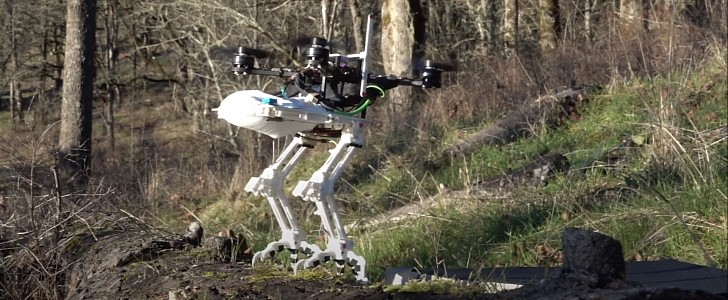Birds are magnificent creatures that can teach us a lot about the art of flying, so it is only logical for humans to study them to come up with smarter, more efficient, and useful types of aircraft. It is what the scientists at Stanford University did, and it helped them develop an agile flying robot inspired by the peregrine falcon.
The SNAG stands for stereotyped nature-inspired aerial grasper and it’s a 3D-printed bird bot with claws. It can fly, perch on various surfaces, catch and carry objects, just like the mighty falcon that was used as the source of inspiration in its development.
Each leg of the SNAG has two motors, one for helping it move back and forth, and another one for grasping. Twenty printing attempts were necessary for the bot to finally reach its current structure, but it was worth it. Now, according to researchers, the flying machine has an impressively strong and high-speed clutch, being able to land and wrap its claws around a branch in about 20 milliseconds. SNAG’s ankles lock, and there’s an accelerometer on its right foot that reports that it’s landed while triggering a balancing algorithm to stabilize it.
Scientists have already conducted several tests with the robot in rural areas and on different surfaces. In all the scenarios, the SNAG was able to catch objects thrown by hand, such as a prey dummy, a tennis ball, and more.
As for the applications of the bird-like robot, the SNAG can get attached to drones and be used for search and rescue missions, wildfire monitoring, to offer just a few examples. Another great application is environmental research, with the SNAG also featuring a temperature and humidity sensor. By having at your disposal a robot that can act like a bird, you can unlock new ways of studying the environment, as explained by William Roderick, mechanical engineer and one of the researchers involved in the project.
Now scientists are moving on to improving the robot’s situational awareness and flight control.
This isn’t the first time nature inspires groundbreaking technologies. We also wrote a piece recently about the F-SAM micro drone, a foldable single actuator monocopter that was inspired by the flight of samara seeds, also known as “twisters” or “whirlers” which have a special way of spinning down to the ground. Then there’s also the microflier, the world’s smallest human-made flying structure, a winged microchip also inspired by the seeds from plants and trees.
Each leg of the SNAG has two motors, one for helping it move back and forth, and another one for grasping. Twenty printing attempts were necessary for the bot to finally reach its current structure, but it was worth it. Now, according to researchers, the flying machine has an impressively strong and high-speed clutch, being able to land and wrap its claws around a branch in about 20 milliseconds. SNAG’s ankles lock, and there’s an accelerometer on its right foot that reports that it’s landed while triggering a balancing algorithm to stabilize it.
Scientists have already conducted several tests with the robot in rural areas and on different surfaces. In all the scenarios, the SNAG was able to catch objects thrown by hand, such as a prey dummy, a tennis ball, and more.
As for the applications of the bird-like robot, the SNAG can get attached to drones and be used for search and rescue missions, wildfire monitoring, to offer just a few examples. Another great application is environmental research, with the SNAG also featuring a temperature and humidity sensor. By having at your disposal a robot that can act like a bird, you can unlock new ways of studying the environment, as explained by William Roderick, mechanical engineer and one of the researchers involved in the project.
Now scientists are moving on to improving the robot’s situational awareness and flight control.
This isn’t the first time nature inspires groundbreaking technologies. We also wrote a piece recently about the F-SAM micro drone, a foldable single actuator monocopter that was inspired by the flight of samara seeds, also known as “twisters” or “whirlers” which have a special way of spinning down to the ground. Then there’s also the microflier, the world’s smallest human-made flying structure, a winged microchip also inspired by the seeds from plants and trees.









